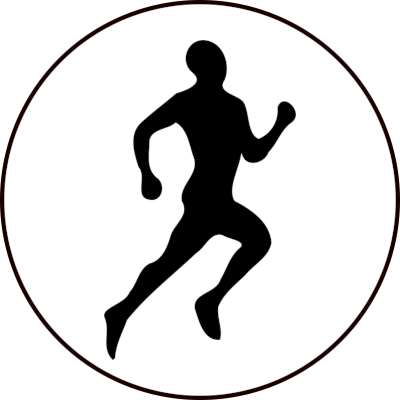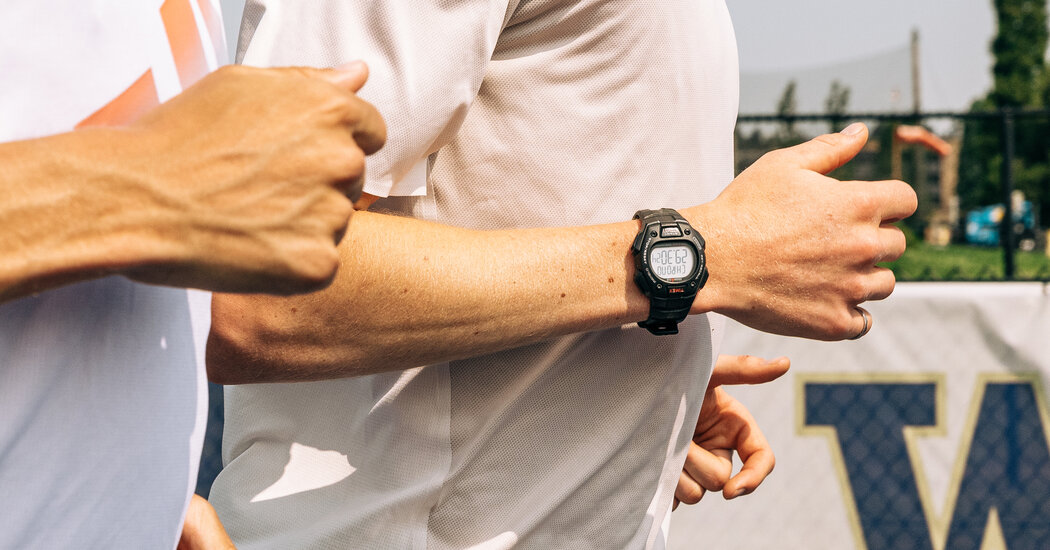"[Heather MacLean, an Olympic 1,500-meter runner] realized her watch was draining the fun from her runs. It was especially apparent to her during a low-key stretch when she was simply trying to build fitness.
I hated that every run I went on, I felt like I had to check my pace and my distance and whatever else,” she said. “So I just decided that I was going to lay off it for a while and switch to a regular watch.”
She never went back. MacLean, 28, who now wears an Armitron Dragonfly that she said she picked up for $10 at Walmart, acknowledged that there were certain workouts when a GPS watch would come in handy, like when she did a tempo run by herself. (Tempo runs are faster than easy jogs, and frequently run at a prescribed pace.) But Mark Coogan, her coach, has long prioritized effort over pace, and MacLean logs her training in minutes rather than in miles.
“I know I’m at the elite level now, so not everything is going to be joyful,” MacLean said. “But when there are things that bring me a lot of joy, I’m going to invest in them. And one of those things is the ability to avoid focusing on my pace during my runs.”
Without the pressure of feeling as if she needs to account for every mile — or, perish the thought, post her workouts for public inspection on Strava, the exercise-tracking platform — MacLean has also gotten better about listening to her body. She has no qualms about bailing on an extra workout if she is feeling beat.
“And I’ll tell Mark that I’m going for a walk instead,” MacLean said. “And he’s like, ‘OK!’”



Maybe I use my watch differently, but I use my watch to set the pace I should run at, and then it ensures I keep myself there without going too fast!
Yeah that’s definitely it for me. Far more often I look at my watch and realise I’m going too fast for the type of run I want to do, and slow down, than the opposite.
Last year I was running a marathon with a target time that perfectly matched one of the pacers, so I stuck to her. But she was going about 10 seconds per k faster than the target pace for the first two thirds or so. If I hadn’t had my watch to know that, when I eventually couldn’t keep up with her after about 26 k I would have felt utterly defeated. As it was I knew I still had a fair bit of wiggle room, and I ended up coming in just under my target time.
Though the opposite does happen too on occasion. Particularly in those faster tempo runs.
I use pre-programmed pace times for my runs, and my watch complains at me when I go above or below that bracket.
Interesting. I’ve seen the option for that on mine but I’ve never used it. How well does it work? I don’t really even trust mine to tell me my “current” pace, preferring to rely on lap average and automatically lapping each kilometre. Does the pace guide work well?
The other obvious worry is hills. If I’ve got a target pace in training, I usually am not thinking about hills in that, and I’d be happy to slow down while ascending them, and I’m probably not going to quite make up the difference on the downhill. Is that not a problem you’ve run into?
So, I used TrainAsOne, which builds a dynamic plan that adjusts to your fitness levels etc.
And when it generates a workout, it exports that to my Garmin. So then when I run, the Garmin has a pace range, and it shows my average pace for that leg, updated in real time, in a nice little interface. Green when I’m within the pace band, red when I’m not.
Also, given that it only cares about your average pace for the leg, it also takes in to account your previous runs and assumes you will run something similar in terms of gradient. It also adjusts for expected heat levels etc.
It will be wrong if you move to a location with a radically different gradient profile, but even then, once you’ve run it, it will take in to account the actual gradient and your pace, so you don’t get punished for running slower on gradients
Oh that’s very interesting to hear. I’ve just signed up for TAO yesterday and I’m excited to try it out.
I must say from what I’ve seen of it so far, it has some weird deficiencies, like the inability to tell it I want my Sunday run to be the longest one—or even that I definitely want a Sunday run at all. Guess I’ve just gotta learn to trust the AI’s wisdom? Seems to sorta go against the idea that it’s about flexibly reacting to your life.
Out of interest, do you have any particular fields it’s helpful to display when running a TAO workout?
You can customise the plan. You can’t tell it “Do my long run on Sundays”, but if the reason you want to do it on Sunday is because you don’t have enough time on the other days, you can cap the maximum time it will give you on a per day basis. You can set it as the default to never do long runs during the week, but then over ride it as needed if you know that you’ll be on holidays, or have a day off etc.
Go out and do your long run on Sunday, and it will rebuild the plan around it.
I just leave them as the default. Which basically means that my Garmin shows me the pace band it wants me to stay inside of for most things, except for recovery periods, when it shifts over to HR instead.
The only issue is, the Garmin defaults to only showing my current lap/leg average pace, and doesn’t show my instantaneous pace. If I ever got around to customising that screen, I’d add instantaneous pace and lap/leg pace to both be visible. As it is, I just swap between screens if I really want to see it
On Coros watches, there’s “effort pace.” I think it’s very close to “gradient adjusted pace” on some other watches. Both give a pace number adjusted for the grade one is running up or down. On Coros, one can make workout targets using effort pace that adjust for hills.
Oh that’s interesting. I run with a Garmin watch, and it looks like Grade Adjusted Pace is something they only added as of the Forerunner X55 generation of watches. I have a Forerunner 935, so it’s not an option for me. But assuming it works well, that’s a potentially really useful field to have.
The downside of Garmin’s very obvious artificially-short lifespan on their devices by almost never providing software updates with new functionality.